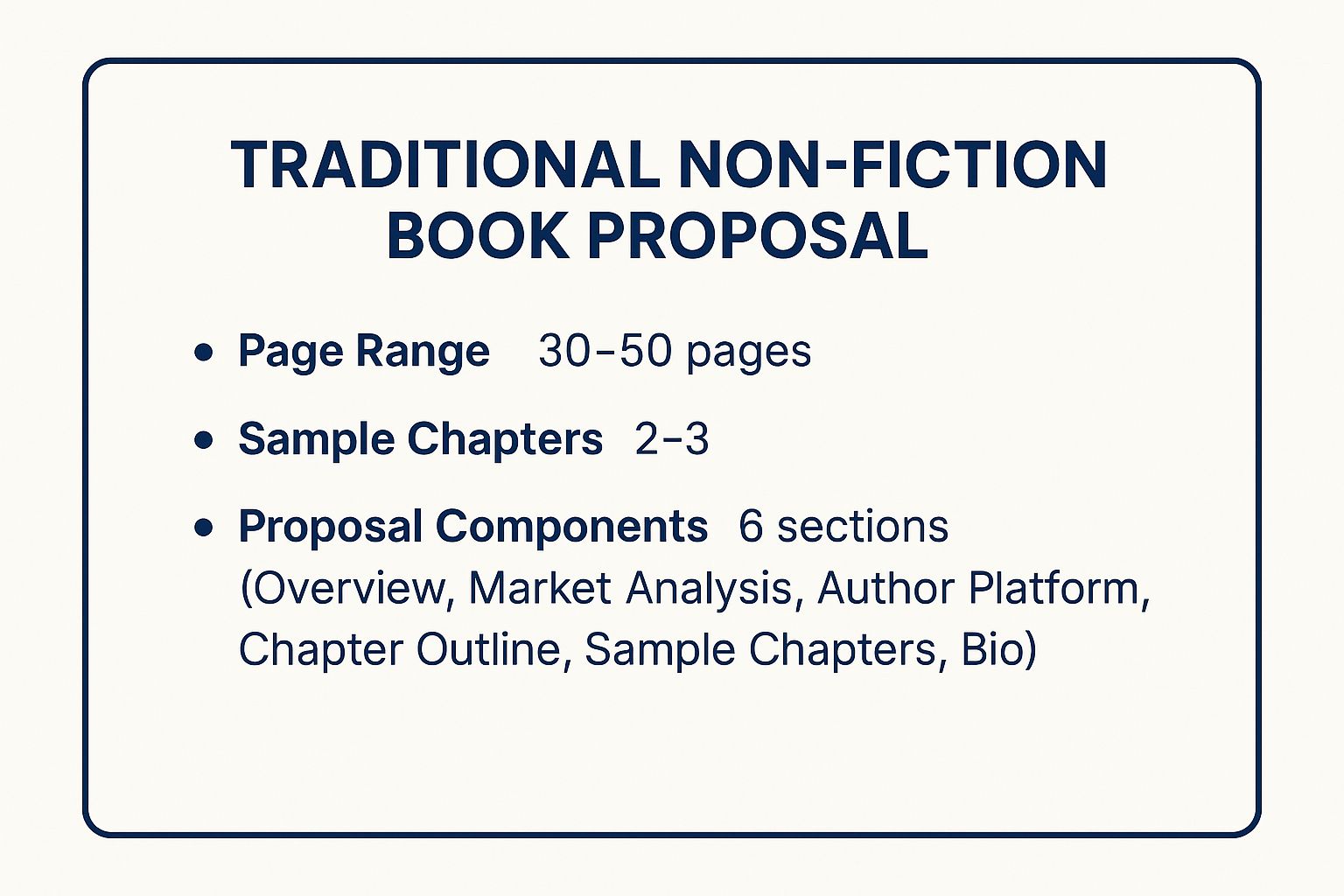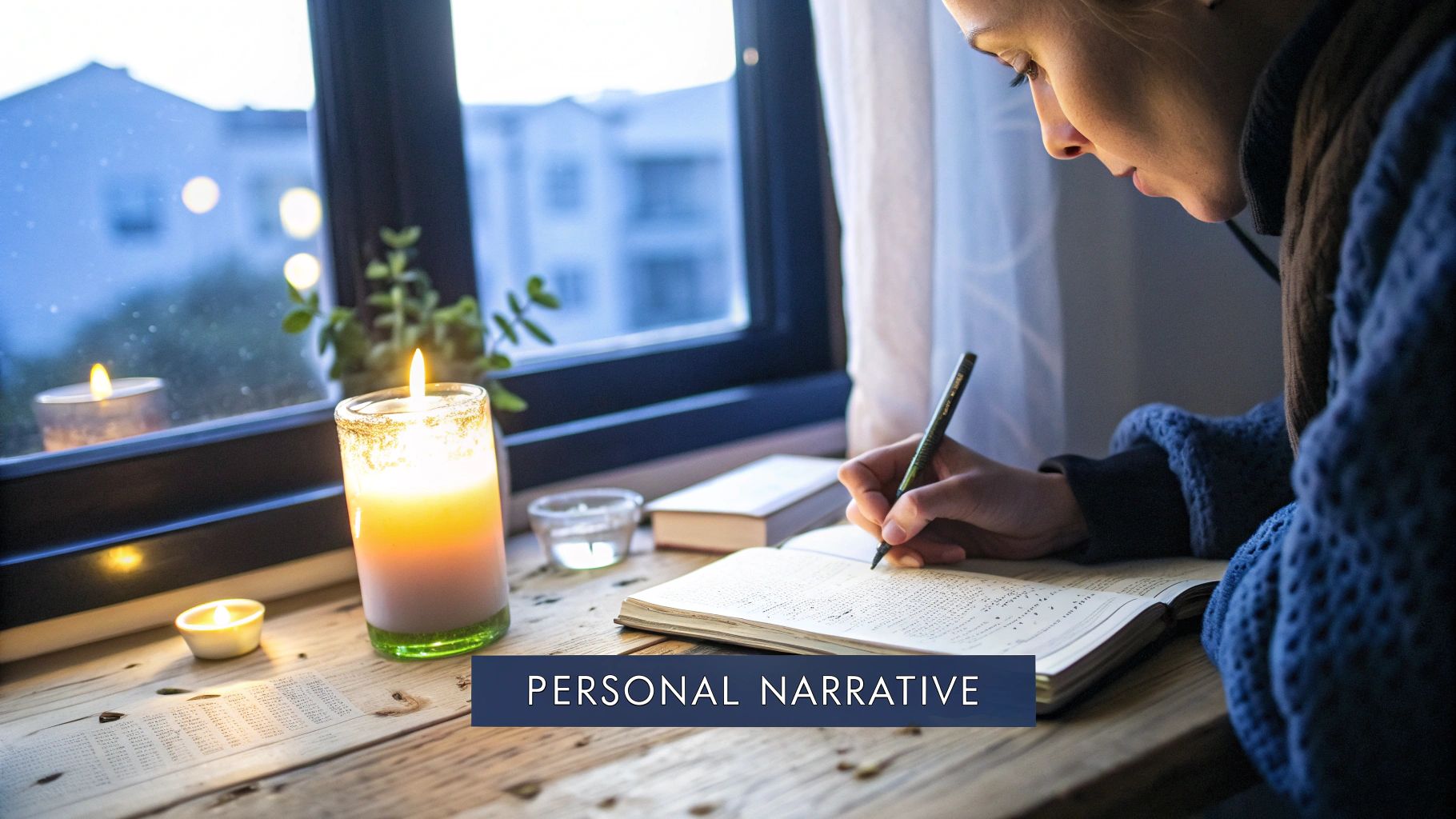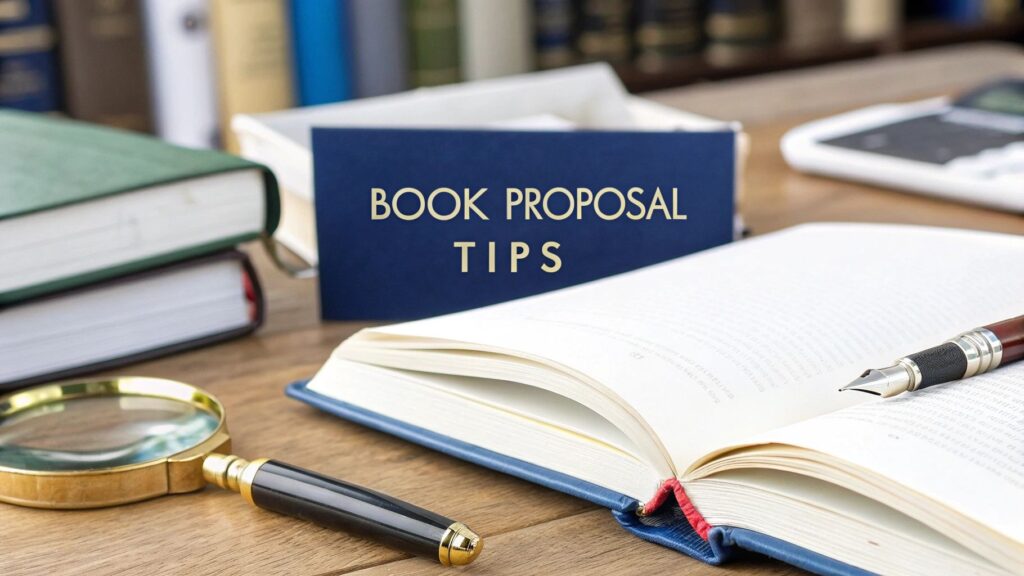Crafting a compelling book proposal is the single most critical step toward landing a traditional publishing deal. It's more than just an idea; it's a meticulously structured business plan for your book that must convince agents and editors your project is a worthy investment. But where do you even start? The secret lies in understanding the right structure and strategy for your specific genre, as a proposal for a memoir will differ significantly from one for a business book. This core principle of tailoring your pitch is universal, and studying examples of general winning bid proposal formats can sharpen your understanding of persuasive document structure.
In this guide, we'll dissect six distinct sample book proposal templates, moving beyond theory to provide a strategic breakdown of what makes them work. You'll get behind-the-scenes insights, actionable tactics, and a clear roadmap to model your own success. We will explore the key components that every agent looks for, from the overview and author bio to the market analysis and chapter summaries. Whether you're writing a gripping memoir, a practical business guide, or a groundbreaking self-help book, these examples will equip you to create a professional proposal that stands out and gets you noticed.
1. Traditional Non-Fiction Book Proposal
The Traditional Non-Fiction Book Proposal is the industry-standard document used to pitch your book idea to literary agents and publishers. It's not just a summary; it's a comprehensive business plan for your book. Think of it as a detailed argument for why your book deserves to be published, demonstrating its commercial viability and your ability to write and promote it effectively. This is the gold standard for authors of business, self-help, history, biography, and memoir.
A strong sample book proposal acts as your primary sales tool. Its goal is to convince a publisher that there's a hungry market for your topic, you are the perfect person to write it, and the book itself will be well-structured and engaging. Proposals for books like James Clear's Atomic Habits or Tim Ferriss's The 4-Hour Workweek followed this exact format to secure major publishing deals.
Strategic Breakdown and Analysis
The power of this format lies in its thoroughness. It forces you to think like a publisher, addressing every potential question or concern upfront.
- The Hook: Your one-page overview must start with a compelling hook that immediately grabs an agent’s attention, clearly stating the book's core promise.
- Market Viability: The market analysis section isn't just a list of similar books. It strategically positions your book against "comps" (comparable titles), highlighting what makes yours unique and necessary.
- Author Platform: This is where you prove you can help sell the book. It’s a quantified summary of your reach, including social media followers, email list subscribers, speaking engagements, and media connections.
To help you understand its core components, the following infographic summarizes the key data points of a standard non-fiction proposal.

The visualization highlights that this is a substantial document, typically 30-50 pages, with the sample chapters proving your writing ability and the core sections building the business case.
Actionable Takeaways
To create a winning proposal, you must be both a writer and a strategist. Research is non-negotiable, as is a clear, confident voice. For a deeper dive into the entire process, learn more about what it takes to become a published author on barkerbooks.com. By mastering this format, you demonstrate your professionalism and understanding of the publishing business, significantly increasing your chances of landing a deal.
2. Memoir Book Proposal Template
The Memoir Book Proposal Template is a specialized document crafted to sell a personal story to agents and publishers. Unlike a standard non-fiction proposal that prioritizes data and author platform, a memoir proposal leads with narrative, emotional resonance, and the universality of the author's experience. It’s a business case built on the power of story, demonstrating that a deeply personal journey has the potential to connect with a broad audience.

This sample book proposal format is essential for authors whose books fall into the memoir category, like Cheryl Strayed's Wild or Jeannette Walls's The Glass Castle. It focuses on convincing an agent that your life story is not just an anecdote but a compelling, structured narrative with a clear beginning, a transformative middle, and a resonant end. The goal is to prove your story’s literary merit and its commercial appeal by highlighting its unique voice and broader cultural relevance.
Strategic Breakdown and Analysis
The strength of a memoir proposal lies in its ability to balance profound personal intimacy with marketable, universal themes. It must prove that one person's life can speak for many.
- Narrative Hook: The overview must function like the back cover of a novel. It should introduce the core conflict and emotional stakes immediately, making an agent desperate to know what happens next.
- Universal Themes: You must explicitly state the universal themes your story explores, such as grief, resilience, identity, or belonging. This shows the publisher a clear path to marketing the book to a wider readership beyond those with identical experiences.
- The Author's Voice: The sample chapters are arguably the most critical component. They must showcase a unique, compelling, and consistent narrative voice that proves you have the writing craft to carry an entire book.
This approach, championed by memoir experts like Mary Karr and Brooke Warner, frames your personal story as a product with a defined audience and a clear narrative arc.
Actionable Takeaways
To succeed with a memoir proposal, you must be a storyteller first and a marketer second. Your primary task is to make the deeply personal feel universally significant. For help structuring your personal story into a compelling narrative, you can get insights from this detailed guide on creating an outline for an autobiography on barkerbooks.com. By mastering this format, you show publishers that you not only have a powerful story to tell but also understand how to frame it for commercial success.
3. Business Book Proposal Framework
The Business Book Proposal Framework is a specialized structure engineered for authors in the business, entrepreneurship, and leadership space. Unlike a standard proposal, this framework intensely focuses on quantifiable outcomes, market demand, and the author's credibility as a thought leader. It's a strategic document designed to convince publishers that the book is not just a collection of ideas but a vital tool for professional and corporate development. This is the go-to format for authors aiming to produce works like Jim Collins' Good to Great or Eric Ries' The Lean Startup.
A powerful sample book proposal using this framework goes beyond storytelling to build a robust business case. Its primary objective is to prove that the book will solve a pressing problem for a defined business audience, creating demand for individual copies, corporate bulk sales, and lucrative speaking engagements. The proposal itself must read like an executive summary from a top-tier consulting firm: data-driven, direct, and authoritative.
Strategic Breakdown and Analysis
The strength of this framework is its relentless focus on ROI for both the reader and the publisher. It frames the book as an investment, not just a purchase, and positions the author as a premier expert.
- Problem/Solution Hook: The proposal must immediately identify a significant pain point in the current business landscape and present the book's core concept as the definitive solution.
- Audience Segmentation: It drills down on the target audience, not just as "business leaders" but as specific roles like "VPs of Operations in mid-cap tech firms" or "startup founders seeking Series A funding," demonstrating a deep understanding of the market.
- Corporate & Bulk Sales Potential: This section explicitly outlines a strategy for B2B sales, including plans for workshops, corporate training tie-ins, and bulk purchase discounts. This showcases additional revenue streams beyond traditional retail.
Actionable Takeaways
To succeed with this framework, you must think like a CEO and write like a consultant. Your proposal needs to be backed by hard data, clear metrics, and an undeniable demonstration of your thought leadership. Reference current business trends, include quantifiable results from your own work, and show you have a plan to leverage your professional network. For authors looking to establish themselves as industry authorities, mastering this proposal framework is a critical first step.
4. Self-Help Book Proposal Model
The Self-Help Book Proposal Model is a specialized framework designed to pitch books focused on personal development, transformation, and practical guidance. Unlike a standard non-fiction proposal, this model places heavy emphasis on the reader's journey and the tangible, life-changing outcomes your methodology provides. It's a persuasive tool that must convince agents and publishers that you have a unique, effective system for helping people improve their lives.

A powerful sample book proposal in this genre goes beyond just presenting information; it sells a promise of transformation. Its primary purpose is to prove there is a widespread problem or desire, you possess the definitive solution, and you can build a community around your teachings. This approach was central to the success of groundbreaking books like Jen Sincero's You Are a Badass and Eckhart Tolle's The Power of Now, which secured deals by demonstrating a clear path to reader empowerment.
Strategic Breakdown and Analysis
The strength of the self-help model is its focus on empathy and results. It requires you to deeply understand the reader's pain points and present your book not just as a text, but as a toolkit for a better life.
- The Reader's Problem: The proposal must open by vividly defining the problem the target reader faces. It should articulate their frustrations and aspirations in a way that creates an immediate emotional connection.
- The Unique Methodology: This section outlines your step-by-step system. It must be clear, easy to follow, and distinct from other books in the market. Publishers look for a signature framework they can brand.
- Proof of Concept: Your author platform is critical, but here it's about demonstrating results. This includes testimonials, case studies, workshop successes, and a strong social media presence where you actively engage with a community seeking your advice.
The visualization above highlights the core pillars of this proposal: a compelling promise, a structured methodology, and a platform that proves you are a trusted guide. This combination assures publishers of both the book's integrity and its commercial potential.
Actionable Takeaways
To succeed with a self-help proposal, you must be a coach and a marketer, not just an author. Your proposal should radiate authenticity and a genuine desire to help. Focus on building a community before you even write the proposal, as a publisher is investing in you as a leader just as much as in the book itself. Mastering this format shows you understand the psychology of the self-help market, making your project a much more attractive investment.
5. Academic Book Proposal Template
The Academic Book Proposal is a specialized document crafted for submission to university presses and scholarly publishers. Unlike its trade counterpart, its primary goal is not mass-market commercial appeal but to demonstrate a significant, original contribution to a specific academic field. This proposal serves as a rigorous argument for your research's importance, its methodological soundness, and its place within existing scholarly conversations. It is the essential format for monographs, scholarly collections, and advanced textbooks.
A well-constructed sample book proposal in this vein convinces an acquisitions editor and peer reviewers that your manuscript fills a critical gap in the literature. It must prove that your work is not only intellectually robust but also has a defined audience, which may include researchers, graduate students, and upper-level undergraduates. Proposals for seminal works published by presses like the University of Chicago Press or Oxford University Press are built on this foundation of scholarly justification and academic rigor.
Strategic Breakdown and Analysis
The strength of an academic proposal is its scholarly precision. It preemptively answers the questions that a panel of expert peer reviewers will ask, showcasing your deep familiarity with the field and your unique contribution to it.
- Scholarly Contribution: The proposal must explicitly state the "so what?" of your research. Clearly articulate how your work challenges, expands, or redefines current understanding within your discipline.
- Methodological Rigor: Briefly outline your research methodology. This demonstrates that your conclusions are based on sound, defensible scholarly practices, whether they are archival, ethnographic, quantitative, or theoretical.
- Course Adoption Potential: A key element for university presses is the book's potential use in university courses. Including a section on which courses could adopt your book as a required or recommended text significantly boosts its appeal.
Actionable Takeaways
Creating a successful academic proposal requires you to be a scholar first and a marketer second. Your primary task is to prove the intellectual value of your work. For guidance on maintaining the correct tone and structure, consulting an Academic Writing Style Guide can be invaluable for ensuring your prose meets scholarly expectations. To secure a contract, you must clearly position your research within its academic context, gather endorsements from respected figures in your field, and present a compelling argument for why your manuscript deserves a place on a university press's list.
6. Cookbook and Recipe Book Proposal
The Cookbook and Recipe Book Proposal is a highly specialized document tailored for the unique demands of the culinary publishing world. Unlike a standard non-fiction proposal, it places a heavy emphasis on visual elements, recipe clarity, and the author's culinary authority. This format is a business case built around taste, aesthetics, and a unique culinary point of view, making it essential for chefs, food bloggers, and home cooks aiming to publish their recipes.
A well-crafted sample book proposal for a cookbook must do more than just describe food; it must make an agent or editor feel the experience of cooking and eating it. It serves as a visual and conceptual appetizer for the final product. Proposals for groundbreaking books like Samin Nosrat’s Salt Fat Acid Heat or Joanna Gaines's Magnolia Table succeeded because they effectively sold a lifestyle and a philosophy, not just a collection of recipes.
Strategic Breakdown and Analysis
The power of a cookbook proposal is its ability to blend creative vision with practical, marketable concepts. It must prove that the recipes work and that the book will stand out on a crowded shelf.
- Visual Concept: This is paramount. The proposal must include sample food photography and a mood board to clearly articulate the book's aesthetic, from rustic and cozy to modern and minimalist.
- Recipe Structure and Testing: You must detail the recipe format, including headnotes, ingredient lists, and instructions. Crucially, you need to document the recipe testing process to guarantee reliability for the home cook.
- Unique Culinary Angle: The proposal must define what makes your cookbook different. Is it focused on a specific dietary trend (e.g., plant-based, gluten-free), a regional cuisine, a cooking technique, or a unique personal story?
Here is a short video that provides insight into what makes a cookbook pitch successful, emphasizing the importance of a unique concept and platform.
The video reinforces that a strong point of view, backed by a clear understanding of the target audience and market, is the foundation of a compelling proposal.
Actionable Takeaways
To secure a deal, your proposal must be a feast for the eyes and a solid business plan. You are selling a tangible, beautiful object as much as you are selling information. Be prepared to invest in professional-quality sample photography to bring your vision to life. Once your project is underway, you will also need to handle the administrative side of publishing, so it's wise to learn more about how you can get an ISBN for your book on barkerbooks.com. By demonstrating both culinary creativity and market awareness, your proposal will prove its potential for success.
Book Proposal Formats Comparison
| Proposal Type | Implementation Complexity 🔄 | Resource Requirements ⚡ | Expected Outcomes 📊 | Ideal Use Cases 💡 | Key Advantages ⭐ |
|---|---|---|---|---|---|
| Traditional Non-Fiction Book Proposal | High – detailed and lengthy process | Significant research and preparation | Comprehensive project overview; strong market positioning | Business, self-help, biographies | Widely accepted; demonstrates expertise |
| Memoir Book Proposal Template | Medium – narrative focus with emotional depth | Requires personal disclosure and reflection | Emotional connection; storytelling impact | Personal narratives and memoirs | Highlights personal storytelling; creative |
| Business Book Proposal Framework | Medium – focused on practical value and metrics | Business credentials and market analysis | Actionable solutions; professional audience | Business and entrepreneurship | Strong ROI focus; leverages professional expertise |
| Self-Help Book Proposal Model | Medium – engagement and stepwise methods | Expertise, content creation, community building | Transformational outcomes; broad readership | Self-improvement, personal development | Large market; multiple revenue streams |
| Academic Book Proposal Template | High – scholarly research and peer review | Extensive research and endorsements | Academic credibility; course adoption potential | Academic and professional markets | Establishes credibility; long-term relevance |
| Cookbook and Recipe Book Proposal | Medium – visual and recipe testing focus | High production costs (photography, testing) | Sensory appeal; multimedia opportunities | Culinary books, recipe collections | Strong visual appeal; gift market potential |
From Proposal to Published: Your Next Steps
You've now explored a strategic arsenal of sample book proposal frameworks, from the market-driven traditional non-fiction model to the specialized structure of a cookbook proposal. The journey through these examples reveals a universal truth: a successful proposal is more than a simple summary; it's a comprehensive business plan for your book. It’s a persuasive argument designed to convince a skeptical agent or editor that your idea is not only brilliant but also commercially viable.
The key takeaway is not to rigidly copy a single template. Instead, your task is to synthesize the most powerful elements from each sample book proposal we've analyzed. Consider blending the compelling narrative hook of a memoir proposal with the concrete value proposition of a business book proposal. Fuse the meticulous market analysis found in a traditional proposal with the clear, actionable chapter summaries of a self-help guide. Your project is unique, and your proposal should be a tailored reflection of its specific strengths.
Distilling Strategy into Action
As you begin drafting or refining your document, focus on three core pillars that agents and editors consistently prioritize:
- Clarity: Is your core concept, target audience, and unique selling proposition immediately understandable? Avoid jargon and complex prose; your goal is to make it easy for a busy professional to say "yes."
- Professionalism: A polished, error-free document signals that you are a serious author who respects the publisher's time and investment. Meticulous formatting, adherence to submission guidelines, and a confident tone are non-negotiable.
- Audience Insight: Demonstrate an unwavering command of who your book is for and where it fits in the current market. This goes beyond naming a few competing titles; it involves a deep analysis of market gaps and reader needs that your book is uniquely positioned to fill.
Ultimately, your book proposal is your first and most critical marketing document. It tells a compelling story about your book's future success. Once that story convinces a publisher, your focus will shift to the exciting next stage: the publishing agreement. Navigating this new territory can be complex. To prepare yourself for that step, having a foundational understanding of publishing agreements is crucial. For a helpful resource, consider this guide on how to read legal contracts, designed to empower authors and professionals.
Building a powerful sample book proposal is your gateway to the publishing world. By applying the strategic insights and actionable takeaways from the examples provided, you are no longer just an aspiring author with an idea; you are a strategic partner ready to bring a valuable product to market. This document is your bridge from manuscript to bookshelf, from dream to a globally distributed reality.
Ready to transform your powerful proposal into a professionally published book? The expert team at BarkerBooks provides the end-to-end guidance you need, from editorial support and ghostwriting to cover design, global distribution, and targeted marketing. Visit BarkerBooks to learn how we can help make your publishing journey a resounding success.
